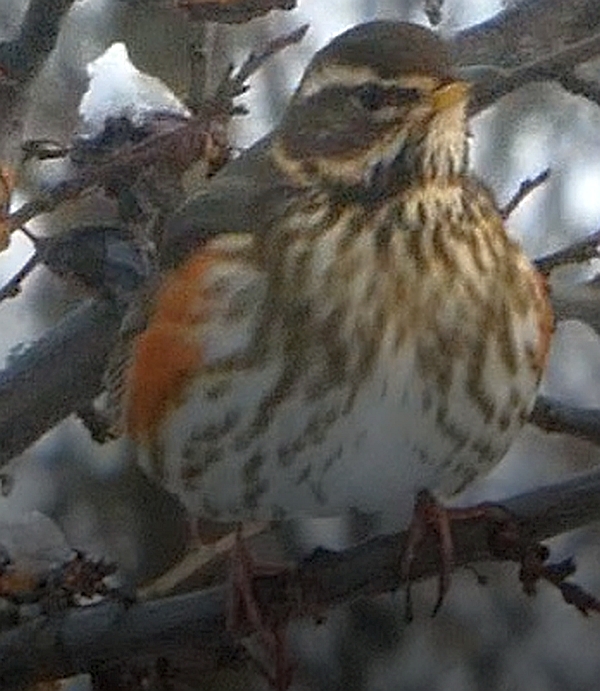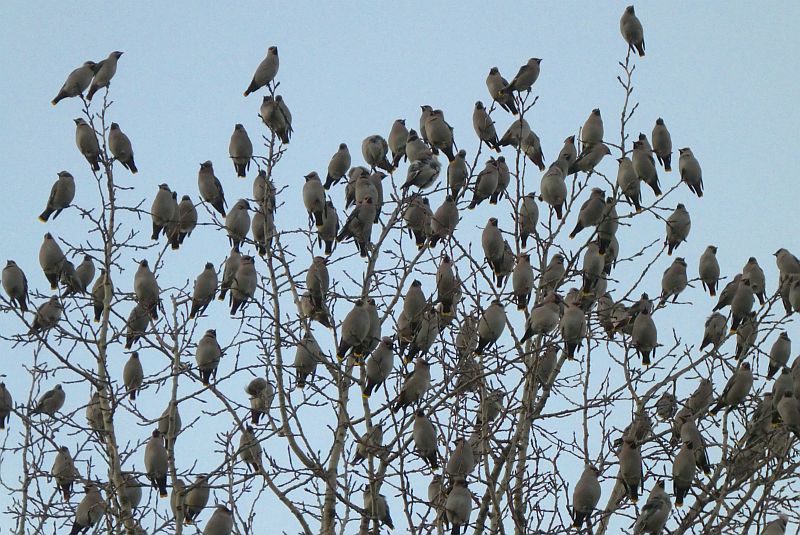Bullfinches (dompap) take a very wide range of seeds in my garden including hawthorn, rowan, nettle and Norway spruce, as well as buds of different trees, but this was the first time I’d seen them taking guelder rose (Viburnum opulus) seed and I could see them discarding the flesh of the berries. Even when they have a rich supply of sunflower seeds, they will continue also to take natural food.
Tag Archives: krossved
Waxwing and Tawny Owl
A small flock of Waxwings (sidensvans) finally arrived at the end of November and have been foraging in the garden since (rowans / rogn failed this year). In these videos, they are eating apples, elderberry and guelder rose berries (epler, svarthyll and krossved). I’ve heard tawny owl (kattugle) calling in the garden regularly recently too and the last video is a recording of one calling.
The Birds
Over the last couple of days there’ve been large numbers of birds in the garden making me think of Alfred Hitchcock’s The Birds, although there have been fortunately no casualties as far as I know. I try to limit the amount of bird food I put out (as its production isn’t good for birds) and it’s good to see that most species are still eating natural food.
This winter there’ve been reports from all over the county of unusual numbers of overwintering bramblings (bjørkefink) with flocks up to 300 birds recorded. I’ve had smaller flocks of 20-30 for some time, but yesterday they were everywhere in the garden and at least 140 birds were present, a new winter record for Malvik kommune! The films below show them both at the bird feeder, feeding on rowan berries (eating the seed and discarding the flesh) and also on the ground perhaps feeding on birch seed?
Apart from that there was a sizeable flock of some 60 waxwings (sidensvans) on guelder rose / krossved (Viburnum opulus) and hawthorn (hagtorn) , 11 bullfinches (dompap), 50 house sparrows (gråspurv), 6 goldfinches (stillits) still mostly on burdock seed, 16 siskins (on birch seed), 6 greenfinches (grønnfink), 2 hawfinches (kjernebiter) seen on plum stones and rowan berries, a single robin (rødstrupe), a couple of fieldfares (gråtrost) on apples and hawthorn, a great spotted woodpecker (flaggspett) and great and blue tits both establishing territories now. In addition, a flock of 500-600 jackdaws (kaie) fly over to the roost every evening.
Bramblings with a hawfinch:
Bramblings with a hawfinch feeding on rowan seed (at the end, both birds are seen to discard the flesh). A greenfinch was also feeding on rowan.
Bramblings on the ground (feeding on birch seed?)
Large flock of bramblings at the bird feeder:
Natural bird food is best
I garden for the birds and other wildlife as well as myself and believe that bought bird food (sunflower seeds) is not necessarily a good thing as it’s imported and largely grown inorganically to the detrement of birds and other wildlife in the country of origin. My observations are that most bird species in our area prefer natural food (including grain in local fields) and several species never or seldom come to bird feeders. Others such as blackcap (munk) are reliant to a large extent on garden berries and fruit.
For these reasons, I put out purchased birdfood including homegrown grain and apples only when the whether is severe. Even here in the north where we have largely had subzero temperatures day and night since November, most birds seem to be finding plentiful natural food this winter. Today, greenfinches (grønnfink) and bramblings (bjørkefink) were feeding on rowan (rogn) berries, I noticed a blue tit (blåmeis) eating nettle seed, waxwings (sidensvans) were taking guelder rose (krossved), hawthorn (hagtorn) and rowan berries (films below), a blackcap was spotted eating one of the last apples still hanging on a tree, fieldfares (gråtrost) were eating hawthorn berries and, for only the second time I noticed goldfinches feeding on chicory (sikkori) seed before switching back to burdock (borre) seed. I grow both burdock and chicory for food and a bi-product of seed saving is that the birds get a share. There are also flocks of siskins (grønnsisik), crossbills (korsnebber) and pine grosbeaks (konglebit) feeding on spruce and pine seed, often in large flocks. Every evening there are maybe a thousand crows (hooded crows / kråke and jackdaws / kaie) that fly into the roost at Vikhammer, still finding grain during our short day in the snow-covered fields. There’s also a local flock of over 90 Canada Geese (Kanadagås) that are overwintering and still able to forage in the fields. There are thousands of wildfowl also on the fjord and I today noted a flock of 250 mallard (stokkand) duck resting in the bay below the house.
Bird feeders can also have negative impact on birds as disease can spread rapidly, such as salmonellosis in greenfinch and house sparrow.
Growing plants in our gardens to supply a greater proportion of winter food for our birds is something many of us can do, but it does mean leaving seed heads to deadhead until spring and encouraging wild plants such as nettles which have multiple uses for us and wildlife. It’s also not as easy as buying a bag of bird seed from the supermarket. Bird friendly plants can be planted in good view of the house. For example, I have a yew tree right next to my kitchen window which allows me to observe berry-eating species such as blackcap, waxwing, robin, fieldfare, redwing and blackbird to within 1m!
I think we should also consider delaying putting out commercial bird food until weather really is severe.
1. Waxwings in slow motion – notice what happens with the rowan berry in the second sequence in the first video:
2. Only the second time I’ve seen goldfinches on chicory:
3. Waxwings on guelder rose berries with bramblings
Redwings
Eurasian redwings (rødvingetrost) seem to becoming more common in winter here. I now have 7 records of single birds since 2015 (December to March) and today there were 4 together feeding briefly with fieldfares (gråtrost) on guelder rose (krossved) berries! Interestingly, 27th December seems to be the best day to see redwings here as I now have records in 2015, 2017 and 2021 on this day!
Snow and fieldfare flock
A small flock of fieldfares (gråtrost) turned up in the garden today after a small snowfall. They were feeding on a few remaining guelder rose / krossved (Viburnum opulus) berries. A single resident fieldfare defended the elderberries, but allowed a blackcap (munk) to share the crop.
Waxwings: soon on the way south?
Here the waxwings join a large flock of bramblings (bjørkefink) and a few other species at the feeding station.
The return of the waxwings
The first two videos show waxwings eating apples opened up by fieldfares and blackbirds yesterday and also eating guelder rose (krossved) berries, so far not touching the elderberries (svarthyll).
Earlier in the day, the waxwings were hunting insects on birch trees and occasionally high into the air in pursuit of insects:
…and the morning after, they had discovered the yew berries!
…and on unharvested redcurrants (rips)….with a fieldfare (gråtrost) and brambling (bjørkefink) at the end of the video!
Waxwings everywhere
1. Waxwings in flight
2. Waxwings on the yew tree by the kitchen window
3. Waxwings on yew berries in the neighbour’s garden
4. Waxwings and sunrise
5. In this film you can hear waxwing poop falling to the ground…I thought it was raining!




